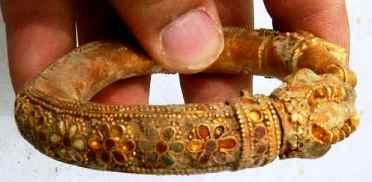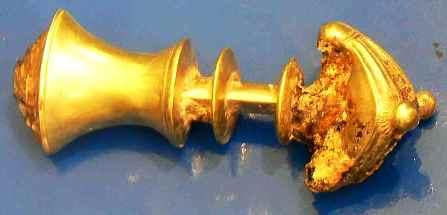IRAN :
Jubaji. Il y a trois ans le trésor de Jubaji était découvert de façon fortuite. La majorité des objets étaient en or et pierres précieuses et dataient du VIIe et VIe siècles av JC. Trois ans après, personne n’a revu ce trésor qui semble avoir disparu … Les scientifiques iraniens tirent la sonnette d’alarme et publient les photos . –
The Circle of Ancient Iranian Studies (CAIS)
http://www.cais-soas.com/news/index.php?option=com_content&view=article&id=135:three-years-on-and-the-islamic-republic-reluctant-to-provide-any-information-about-the-priceless-jubaji-treasure-&catid=43
- During the excavation for laying water mains and supply pipes in the village of Jubaji in February 2007, workers accidentally discovered a magnificent ancient treasure. The hoard of jewels and precious stones were placed in a bronze coffin. The majority of the objects are made of gold and date to 7th and 6th centuries BCE, from the Perso-Elamite (Achaemenid’ pre-dynastic) to early Achaemenid dynastic Empire periods.

The village of Jubaji is located near the city of Ramhormoz in Iran’s southwestern province of Khuzestan.

The discovered artefacts, majority Achaemenids are richly decorated including: a ring-of-power, bracelets, cuffs, necklace, chain, charms, lockets, pendants, buttons, beads, rings, pins, hit of ceremonial dagger or sword and various bronze human and animal figurines. Some of the jewelleries are adorned with agate, carnelian and other precious stones.

The high quality of the artefacts belonging to various periods of Iranian history, from Elamites to the Achaemenids demonstrates they were family heirlooms. The presence of an Achaemenid style ‘ring of power’ among the objects also indicates they were belonged to an affluent family who occupied a public office. The treasure was buried either by the family themselves during the 4th century BCE to be kept safe from Alexander II and his looting army, or was buried by the Greco-Macedonian looter, planning to return to retrieve them after their campaign.

Last September ICHTHO issued a statement, reporting the artefacts had been restored but would not be shown until security measures in the Samimi Building were in place. To facilitate the show, the public donated generously to allow a costly high-tech security system to be installed.

A year on and there is no sign of the artefacts in the new museum, or even any comment from the regime on the whereabouts of the treasure, nor granted access to trusted-cultural-figures to examine the priceless artefacts in order to ease the public’s concerns about their fate.

Many fear that the main reason for the regime’s past excuses and current reluctance is because the ancient Iranian treasures are no longer in the country and have been sold to either international private collectors or museums.

The Islamic Republic and illicit traffic of Iran’s Cultural Properties
Since 1979 and the rise of theocratic-totalitarian Islamic regime to power, the fundamentalists have initiated a programme of de-Iranianisation of the country. The pre-Islamic Iranian heritage has been targeted and the historical and archaeological sites damaged or destroyed by various methods – openly or under the guise of development projects. In the meanwhile the mafia-style ruling clerics and their families have been involved in the lucrative illicit trafficking of Iran’s cultural properties.

The regime’s illicit activities mainly target pre-Islamic period of Iranian history, including looting archaeological sites, stealing artworks from museums and ethnological objects from rural areas have become frequent events in Islamic Iran.
The Islamic republic’s abominable acts not only are endangering Iran’s pre-Islamic heritage, but also endangering all the material and cultural traces left by the mankind.

Traffic of Iranian artworks is a crime against human heritage. The cultural and police institutions such as ICOM, UNESCO and INTERPOL, which internationally are active in the fight against the looting of cultural property, unfortunately have closed their eyes to Iran’s issue – as the rest of the world have chosen to remain silent with the abuse of human rights in Iran, as their interest and trading with the Mullahs’ regime could be placed in jeopardy.

A leading Iranian cultural and heritage figure who lives in Iran and wished to remain anonymous for his safety, in speaking with CAIS warned the international private collectors and museums: “dealing or purchasing Iran’s national heritage, which has been smuggled out of Iran in recent decades are nothing but handling or buying stolen goods. It is immoral and illegal which should be stopped.”

He added: “sooner or later, after the inevitable fall of the despotic regime of Mullahs in Iran, the future free and democratic government of Iran, as the Israelis went after the Nazi criminals, we will go after these dealers and buyer to retrieve our national heritage. Rest assured we will make sure the guilty parties will be prosecuted in international courts.”